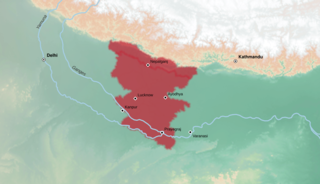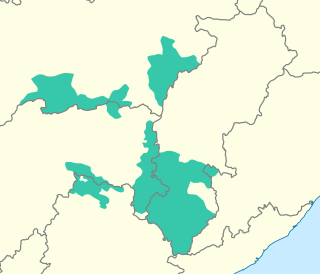
Madhya Pradesh is a state in central India. Its capital is Bhopal, and the largest city is Indore, with Gwalior, Jabalpur, Ujjain, Dewas, Sagar, Satna, and Rewa being the other major cities. Madhya Pradesh is the second largest Indian state by area and the fifth largest state by population with over 72 million residents. It borders the states of Uttar Pradesh to the northeast, Chhattisgarh to the east, Maharashtra to the south, Gujarat to the west, and Rajasthan to the northwest.

The Indo-Aryan languages are a branch of the Indo-Iranian languages in the Indo-European language family. As of the early 21st century, they have more than 800 million speakers, primarily concentrated in Bangladesh, India, Pakistan, Sri Lanka, Maldives and Nepal. Moreover, apart from the Indian subcontinent, large immigrant and expatriate Indo-Aryan–speaking communities live in Northwestern Europe, Western Asia, North America, the Caribbean, Southeast Africa, Polynesia and Australia, along with several million speakers of Romani languages primarily concentrated in Southeastern Europe. There are over 200 known Indo-Aryan languages.

Bundeli or Bundelkhandi is an Indo-Aryan language spoken in the Bundelkhand region of central India. It belongs to the Central Indo-Aryan languages and is part of the Western Hindi subgroup.

Bagheli or Baghelkhandi is a Central Indo-Aryan language spoken in the Baghelkhand region of central India.

Saurashtra is an Indo-Aryan language spoken primarily by the Saurashtrians of Southern India who migrated from the Lata region of present-day Gujarat to south of Vindhyas in the Middle Ages.

Awadhi, also known as Audhi, is an Indo-Aryan language spoken in the Awadh region of Uttar Pradesh in northern India and in Terai region of western Nepal. The name Awadh is connected to Ayodhya, the ancient city, which is regarded as the homeland of the Hindu god Rama. It was, along with Braj, used widely as a literary vehicle before being displaced by Hindi in the 19th century.

The Hindi Belt, also known as the Hindi Heartland, is a linguistic region encompassing parts of northern, central, eastern, and western India where various Northern, Central, Eastern and Western Indo-Aryan languages are spoken, which in a broader sense is termed as Hindi languages, with Standard Hindi serving as the lingua franca of the region.

Mahakoshal or Mahakaushal is a region of central India. Mahakoshal lies in the upper or eastern reaches of the Narmada River valley in the Indian state of Madhya Pradesh. Jabalpur is the largest city in the region. Nimar region lies to the west, in the lower reaches of the Narmada valley.
Dramatic Prakrits were those standard forms of Prakrit dialects that were used in dramas and other literature in medieval India. They may have once been spoken languages or were based on spoken languages, but continued to be used as literary languages long after they ceased to be spoken. Dramatic Prakrits are important for the study of the development of Indo-Aryan languages, because their usage in plays and literature is always accompanied by a translation in Sanskrit.

Chhindwara district is one of the major districts of Madhya Pradesh state of India, and Chhindwara town is the district headquarters. Chhindwara was the largest district in Madhya Pradesh with an area of 10,293 square km before the bifurcation of Pandhurna district. The district is part of Jabalpur division.

Gondi (Gōṇḍī), natively known as Koitur, is a South-Central Dravidian language, spoken by about three million Gondi people, chiefly in the Indian states of Madhya Pradesh, Maharashtra, Chhattisgarh, Andhra Pradesh, Telangana and by small minorities in neighbouring states. Although it is the language of the Gond people, it is highly endangered, with only one fifth of Gonds speaking the language. Gondi has a rich folk literature, examples of which are wedding songs and narrations. Gondi people are ethnically related to the Telugus.

Korku is an Austroasiatic language spoken by the Korku tribe of central India, in the states of Madhya Pradesh and Maharashtra. It is isolated in the midst of the Gondi people, who are Dravidian, while its closest relatives are in eastern India. It is the westernmost Austroasiatic language.

The Western Hindi languages, also known as Midland languages, are a branch of the Indo-Aryan language family spoken chiefly in Haryana, western Uttar Pradesh and Bundelkhand region of Madhya Pradesh, in Northwest and Central India. The Western Hindi languages evolved from Sauraseni Prakrit. The most-spoken language in the Western Hindi language family is Standard Hindi, one of the official languages of the Government of India and one of the 22 Scheduled Languages of India.

Uttar Pradesh is a multilingual state with 3 predominant languages and 26 other languages spoken in the state. The languages of Uttar Pradesh primarily belong to two zones in the Indo-Aryan languages, Central and East.
Varhadi or Varhadi-Nagpuri is a dialect of Marathi spoken in Vidarbha region of Maharashtra and by Marathi people of adjoining parts of Madhya Pradesh, Chhattisgarh and Telangana in India.

The Central Indo-Aryan languages or Hindi languages are a group of Indo-Aryan languages spoken across Northern and Central India. These language varieties form the central part of the Indo-Aryan language family, itself a part of the Indo-European language family. They historically form a dialect continuum that descends from the Middle Prakrits. Located in the Hindi Belt, the Central Zone includes the Dehlavi (Delhi) dialect of the Hindustani language, the lingua franca of Northern India that is the basis of the Modern Standard Hindi and Modern Standard Urdu literary standards. In regards to the Indo-Aryan language family, the coherence of this language group depends on the classification being used; here only Eastern and Western Hindi languages will be considered.

The Eastern Hindi languages, also called East Central languages, are a branch of the Indo-Aryan language family spoken chiefly in Awadh region of Uttar Pradesh, Baghelkhand region of Madhya Pradesh, and Chhattisgarh, in Northern and Central India. Eastern Hindi languages evolved from Ardhamagadhi Prakrit.
Rangri may refer to the following Indo-Aryan dialects:

Pawari or Bhoyari is an Indo-Aryan dialect of central India, exclusively spoken by the people of the Kshatriya Pawar caste. It is a dialect of the Rajasthani Malvi language, primarily spoken in the regions of Betul, Chhindwara, Pandhurna and Wardha districts by the people of Kshatriya Pawar caste. It is the same language these people used to speak in their original homes in Rajasthan and Malwa. Between the 13th and 17th centuries, the Pawars migrated from Rajasthan and Malwa to the Satpura and Vidarbha regions, settling primarily in Betul, Chhindwara, Pandhurna, and Wardha districts. This language is exclusive to the Pawar community; no people of other castes speak this language, clearly showing the connection of Pawars to Rajasthan and Malwa.













